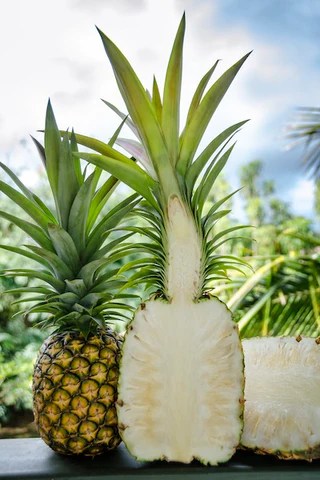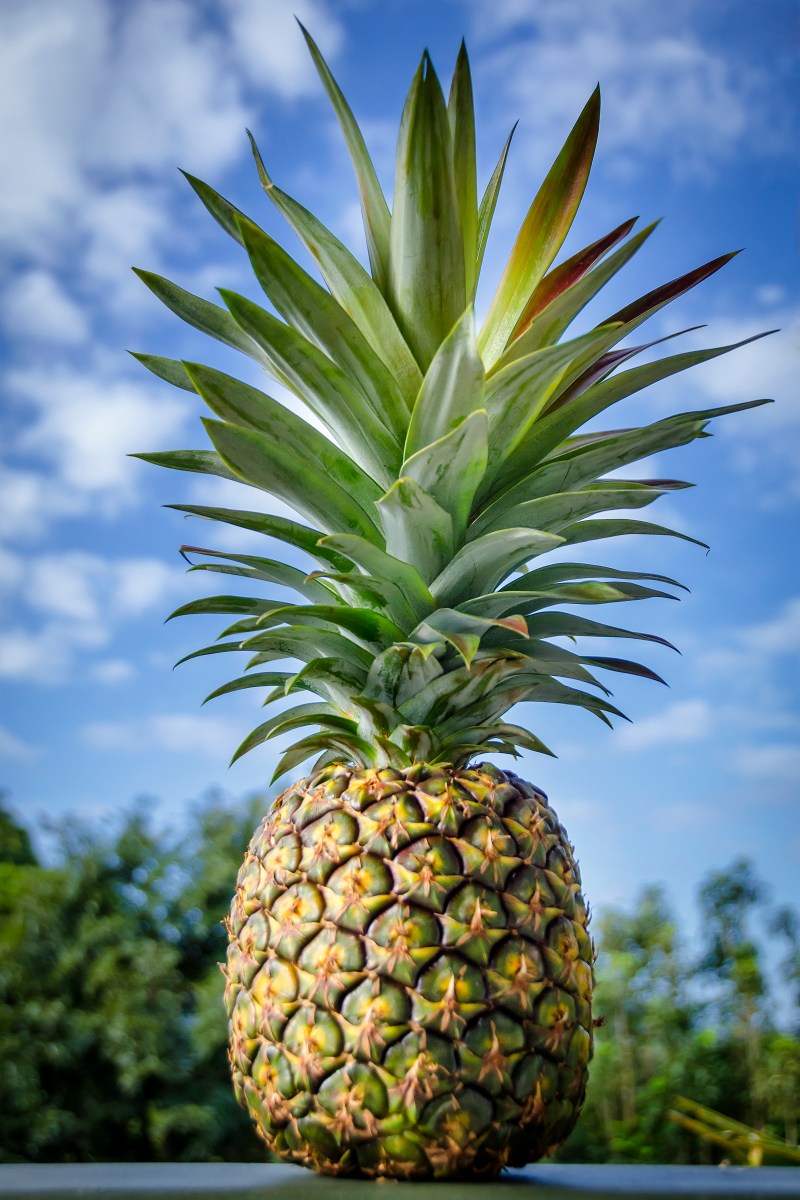Pineapple Overview
Pineapple, Ananas comosus, is a tropical, herbaceous perennial and is the leading edible member of the Bromeliaceae family of plants which include many types of bromeliads. Unlike most other bromeliads, which are epiphytes and many are strikingly ornamental pineapples love sunlight.
The pineapple plant has a tight rosette of long green stiff leaves with spiky tips for protection.
During the seasonal bloom at 12-18 months of age, fruits start to grow from a central leader which puts forth an inflorescence of many small purple or red flowers. This composite of flowers each form into what is referred to as fruitless, which grow together to form a cone-shaped, compound, juicy fruit. As the stem continues to grow it produces at its apex a tuft of stiff, short leaves. This will fully develop into the crown or top of the pineapple. Hummingbirds are the principal pollinators of pineapple, which is why the importing of hummingbirds to Hawaii is forbidden. Pineapple that is not pollinated has no seeds and is obviously more desirable.
Propagation of pineapple is by new vegetative growth consisting of slips that arise from the peduncle just below the fruit, suckers that originate at the base of the plant, and the crown on top of the fruit.
The tough waxy rind of Kauaʻi Sugarloaf is softer than most varieties and the fleshy fruit is less fibrous as well. Kauaʻi Sugarloaf has a creamy white flesh. Most pineapple has yellow flesh and is somewhat fibrous. The core of Kauaʻi Sugarloaf is completely edible and is not woody or stringy as is the case in other varieties of pineapple.

How to grow your own Sugarloaf Pineapple
- Snap the top off, or cut right above the fruit. If some of the fruit is stuck to the top cut all the fruit off. Don’t be afraid to cut a little into the crown. Decaying fruit can cause a myriad of problems when planting. Then peel off the small lower leaves to expose approximately 2 inches.
- Let it sit for at least a week in a dry, well-shaded place such as a garage.
- Plant in soil that drains well. Full sunlight is best. Pineapple cannot tolerate a frost.
- Water lightly. Overwatering is the easiest way to hurt the plant.
- Fertilize by foliar application, which is liquid fertilizer sprayed on the leaves, about once or twice a month, with a formula for acid-loving plants.
- The larger you can grow the plant the larger the fruit will be.
- The larger you can grow the plant before it flowers, the larger the fruit will be. Pineapple usually takes 18 to 24 months to produce the first fruit. One plant = one fruit. When the plant is old enough, usually at least 12-18 months, it will produce a flower at the next solstice and takes about five months to ripen from when you see the flower. Growing pineapple in areas where you need to take the plant inside due to frost, and snow will delay maturity but eventually, it will likely flower, but it will usually take more than 24 months, sometimes significantly more.
- When the plant is old enough it will produce a flower at the next solstice and takes about five months to ripen from when you see the red-heart stage, which is just before the flowering stage. The pictures on my website show these stages.
- Pick when you see yellow dots in the green eyes, which should be plump, all the way from bottom to top.
Using color as a guide for determining ripeness for your standard yellow or gold pineapple would be considerably different than determining ripeness for Kauaʻi Sugarloaf White Pineapple. A golden yellow color on a yellow-fleshed pineapple is usually a good thing but a golden yellow color on a Kauaʻi Sugarloaf White Pineapple would be a clear indication of an overripe Sugarloaf Pineapple that is already past its prime and possibly even beginning to ferment.
A pineapple will not ripen anymore post-harvest. Some fruits ripen off of the tree as the sugars begin to concentrate but pineapple is not one of these fruits. The flavor of the pineapple can change post-harvest, but it will not ripen more.
A fully ripe pineapple picked at its peak is too fragile to be shipped, hence buy from local farmers. Know your farmer. Ask questions. Two indicators of a good pineapple are ripeness and deterioration.
How to know if a Sugarloaf Pineapple is ripe
The perfectly ripe Kauaʻi Sugarloaf Pineapple will be mostly a rich green color with yellow dots in the center of the eyes. The eyes should be fully developed and look swollen, not flat, with a yellow center. At the very least, the yellow dots in the center of the eyes should be evident around the base of the fruit.
At a glance, the flesh of Kauaʻi Sugarloaf is rich green and the outside flesh will feel much harder than another pineapple, even though the inside of Sugarloaf is softer, it has been described as creamy with no strings and with an edible core.
A pineapple that is heavy for its size in comparison to other pineapples the same size will be sweeter. Sugar weighs more than water, hence a really sweet fully ripened pineapple is heavier than an unripe pineapple of the same size.
Kauaʻi Sugarloaf is much sweeter and hence it will feel heavy for its size.
Sugarloaf Pineapple is the lowest acid, sweetest, most delicious, and fullest flavored pineapple.
MYTH: The ability to pull a leaf from the crown, the top of the pineapple, as an indication of ripeness is a complete myth, despite the enduring popularity of this falsehood.

Growing Pineapple
Pineapple needs full sun and well-drained soil. Twist the leafy top off the pineapple and let it “harden off” by letting it sit around in the garage or anywhere out of the elements for a couple of weeks or even a month is fine. Remove two to three inches of the lower leaves – you will see bumps underneath that are where roots will form. Plant in barely damp soil packing tightly around the base.
Do not over-water. Pineapples are bromeliads and so feed through their leaves. Although ground fertilizer is necessary for good root development it will not feed the plant. Every 3-4 weeks feed by foliar application with fertilizer for acid-loving plants, such as for azalea, coffee, etc.
Most failures in growing pineapple are a result of over-watering, under-fertilizing, lack of sun, and impatience with the 18-24 months it takes to grow. Be forewarned that the pineapple may appear to be doing nothing or even look worse when in fact it is developing and will be fine and start growing months later. Keep soil free of nematodes, ants, mealy bugs, and rodents.
. . . . .
Recommended links:
- Social History of the Pineapple
- L A Times: Hawaii’s agricultural side: Kauai
- Pineapple Gardening Information
- Pineapple information from Purdue University
- Univ. Hawaii College of Tropical Agriculture and Human Resources
Other great links:

